Abstract
Background: Antiretroviral treatment is recommended for all people living with HIV/AIDS regardless of CD4 + T cell count and the presence or absence of symptoms, with the aim of reducing the risk of disease progression and preventing transmission. There are multiple factors that are related to virological failure; one of the most important and complex for its control is the lack of adherence to treatment; in addition there are other factors that influence the treatment failure: lack of social or family support, low socioeconomic level, low educational level, unemployment, previous antiretroviral therapy, early age at the start of treatment and male sex.
Aim: The purpose of this study is to identify the factors related to the failure of antiretroviral treatment in patients with HIV infection in Tijuana, Mexico.
Design and Setting: Comparative cross-sectional study.
Methods: In 394 patients in the Family Medicine Unit #27, Tijuana, Baja California, failure of antiretroviral treatment, age, sex, occupation, schooling, viral load, age at start of treatment, number of previous treatments, drug use and lymphocyte count CD4 were measured to make an association between them searching associated factors. For statistical analysis, association was established with chi-squared test with 95% interval confidence (p<0.05).
Results: The association between failure to treatment and associated factor showed the following results: age (p= 0.32), sex (p= 0.99); occupation (p=0.04), schooling (p= 0.28), age of start treatment (p=0.56), number of previous treatments (p=0.01), drug use (p=0.90), smoking (p=0.24), alcoholism (p=0.02), sexual practice (p=0.51).
Conclusion: According to research, the most frequent and relevant factors associated with treatment failure is the occupation, number of previous treatments and alcoholism; focus on these factors can help us to develop useful and effective strategies.
Keywords: HIV; Failure to treatment; Associated factors
Introduction
The epidemic of Human Immunodeficiency Virus/Acquired Immune Deficiency Syndrome (HIV/AIDS) continues to be a public health problem and the most important pandemic of modern times. HIV infection, known since 1981, has the highest case-fatality rate; currently known as a chronic-type infectious disease [1]. In 1983, the virus was identified, only two years after the first cases reported. Subsequently, the tropism was demonstrated by CD4 + T lymphocytes, where the transcription of the genome begins and in a few hours a massive viral replication occurs with destruction of the infected cells, which produces a general and serious alteration of the immune function [1]. The transmission of HIV depends on two factors: risky sexual practices and viral load, which is more important for transmission; a higher viral load increases the risk of infecting another person; on the contrary, if the viral load remains undetectable, the risk is minimal [2-3].
Approximately 96% of infected people do not know the mechanism of transmission of the disease [4]. HIV infection is considered primarily sexually transmitted, this is the main route of transmission [5]. The diagnosis of the infection is made by detecting the virus (viral load); the Western Blot test detects the presence of the p24 antigen and the ELISA test the antigens or antibodies of the virus [6-7]. The antiretroviral management guide for people with HIV tells us that a patient has virological control when they have a viral load below 50 copies/ml in a persistent and uninterrupted manner. Virological failure is defined as a viral load suddenly above 200 copies/ml from 6 months after initiation of antiretroviral treatment (ART); or, an incomplete response, if after 3 months the viral load has not decreased at least one logarithm, once ART has begun or when the treatment has been changed. A viral load elevation not only indicates virological failure, a low level viraemia may occur, that is, more than one consecutive viral load above 50 copies/ml but less than 200 copies/ml; this may be associated with increased risk of developing virus resistance, failure of virological control in the future, or persistent immune hyperactivation [8].
Another reason why the viral load can be high is a blip, that is, detectable viral load values undetectable previous and subsequent viral load. An isolated blip does not present clinical repercussions; but a frequent blip is associated with an increased risk of virology and resistance failure. There are multiple factors that are related to virological failure; one of the most important and complex for its control is the lack of adherence to treatment; adherence is defined as the degree of compliance of people to medical indications, including prescribed therapies, attendance at their follow-up appointments, dietary recommendations and intake of treatment above 95% [8]. In addition to the lack of adherence, there are other factors that influence the treatment failure: lack of social or family support, low socioeconomic level, low educational level, unemployment, previous antiretroviral therapy, early age at the start of treatment and male sex [9].
People with HIV infection and drug addiction are still a group of interest for health personnel due to the complications that may occur: diseases or adverse effects to the treatment, progression of the disease and greater probability of disinterest in their health. The consumption of alcohol alone, or simultaneous with illicit drugs specifically heroin, cocaine, marijuana and methamphetamines is associated with greater probability of failure to ART [9]. Antiretroviral treatment is recommended for all people living with HIV/AIDS regardless of CD4 + T cell count and the presence or absence of symptoms, with the aim of reducing the risk of disease progression and preventing transmission. The first line of antiretroviral treatment (ART) includes two nucleotide reverse transcriptase inhibitors and one nonnucleoside reverse transcriptase inhibitor. The choice of second-line treatment depends on the antiretroviral drugs used for the first line and the activity against the virus [10]. Based on the above, the main objective of this research is to identify the factors related to the failure of antiretroviral treatment in patients with HIV infection in Tijuana, Mexico.
Materials and Methods
A comparative cross-sectional study was carried out in the Family Medicine Unit #27 (FMU-27), of the Instituto Mexicano del Seguro Social (IMSS), located in Tijuana, Baja California, Mexico, in adults that met the following inclusion criteria: patients con HIV infection in antiretroviral treatment for at least 6 months, age greater than 18 years, any sex, it was not necessary to sign the informed consent due to the fact that only clinical records were reviewed; medical records with incomplete information were excluded. The following data were obtained directly from medical records: age, sex, occupation, marital status, schooling and quality of life. The procedure for the data collection was as follows: age was calculated in years according to the year of birth; sex was determined according to phenotypic characteristics of each patient; occupation and schooling was determined asking directly to patients; viral load, lymphocyte count, number of treatments, age at the beginning of treatment, intravenous drug use and alcoholism was collected directly from the medical records.
The recollected data was integrated into data collection sheets and analyzed using the SPSS program version 20 in Spanish, where we applied descriptive statistics; for qualitative variables, frequencies and percentages were used and for quantitative variables, mean and standard deviation were used. For the bivariate analysis, Ji-Square test was used to determinate association and statistically significant differences between the groups. The Kolmogorov-Smirnoff test was used to establish the normality of the data. It was considered a p<0.05 as statistically significant, with a 95% confidence interval. The Protocol was authorized by the Local Committee of Research and Ethics in Health Research from the Family Medicine Unit #27, where this study took place.
Results
We analyzed a sample of 394 patients older than 18 years. The most frequent age group was 30-39 years (Graphic 1). Of the patients included (Graphic 2), 90 were women (22.8%) and 304 men (77.2%). In the occupation (Graphic 3), the majority of patients were workers (67.3%, n= 265), 11.7% professionals, 10.9% unemployed and 10.2% farm workers. In schooling, 6.1% have no studies; 23.1% primary, 34.5% secondary, 28.9% high school and 6.9% completed a bachelor's degree. It was found that 35 (8.9%) patients presented failure to antiretroviral treatment in the last 3 years.
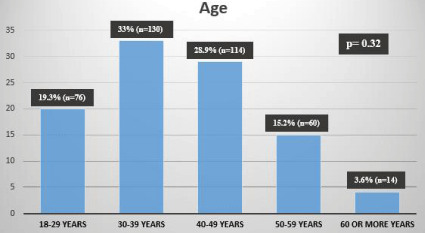
Graphic 1: Descriptive analysis of the distribution by age.
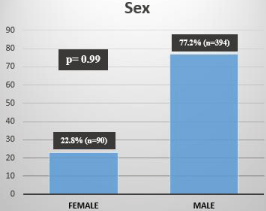
Graphic 2: Descriptive analysis of the distribution by sex.
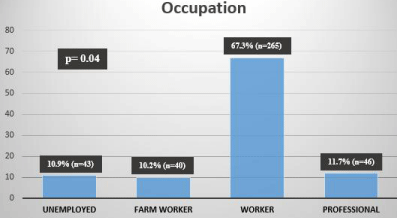
Graphic 3: Descriptive analysis of the distribution by occupation.
We observed that most of the patients started treatment between 19 and 39 years of age (Graphic 4) and 81.2% had only one antiretroviral treatment since diagnosis (Graphic 5). In drug addiction, we found that 15% (n= 59) of the participants consumed some type of drug; 23.1% (n= 91) were active smokers and 29.4% (n= 116) consume some type of alcoholic beverage (Graphic 6). In sexual practice (Graphic 7), 30.2% (n= 119) of the participants were homosexual, 6.6% (n= 26) bisexual and 63.2% (n= 249) heterosexual. For bivariate analysis we make an association between failure to antiretroviral treatment and associated factors finding the following results: age (p= 0.32), sex (p= 0.99); occupation (p=0.04), schooling (p= 0.28), age of start treatment (p=0.56), number of previous treatments (p=0.01), drug use (p=0.90), smoking (p=0.24), alcoholism (p=0.02), sexual practice (p=0.51).
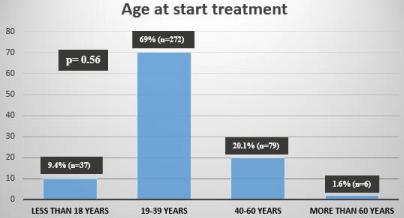
Graphic 4: Descriptive analysis of the distribution by age at start treatment.
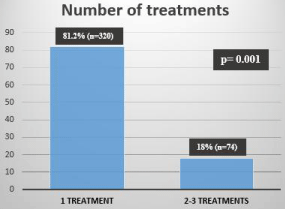
Graphic 5: Descriptive analysis of the distribution by number of treatments.
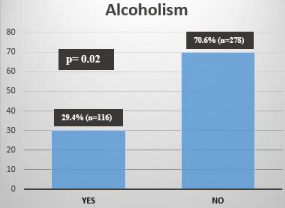
Graphic 6: Descriptive analysis of the distribution by alcoholism.
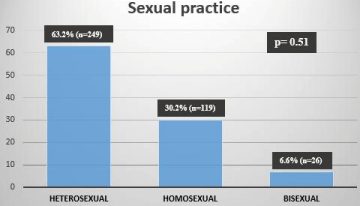
Graphic 7: Descriptive analysis of the distribution by sexual practice.
Discussion and Conclusion
HIV infection is a public health problem. The lack of information, poor cooperation and interest of the population to the problem results in failure to treat, abandonment or denial of the disease. Failure to antiretroviral treatment is manifested by the increase in viral load in the first 6 months of the start of treatment or at the change of treatment; it can also occur if after 3 months the viral load remains high. According to research, the most frequent and relevant factors associated with treatment failure is the occupation, number of previous treatments and alcoholism; focus on these factors can help us to develop useful and effective strategies. First-contact physicians should help strengthen preventive measures, adequate information and timely screening to avoid infection and complications of the disease. Close monitoring of the disease can benefit the patient and reduce the current HIV/AIDS epidemic.
References
- Gutiérrez F. Infección por el VIH/SIDA: El principio del fin de la primera gran pandemia contemporánea? Rev Clin Esp. 2017; 217: 468- 472.
- Skarbinsky J, Rosenberg E, Paz-Bailey G, Hall HI, Rose CE, Viall AH, et al. Human Inmunodeficiency Virus Transmission at Each Step of the Care Continnum in the United States. Intern Med. 2015; 175: 588-596.
- Dávila ME, Gil MA, Tagliaferro ZA. Conocimiento de las personas que viven con con el virus del VIH/SIDA sobre la enfermedad. Rev Salud publica. 2015; 17: 541-551.
- Madgison JF, Li X, Mimiaga MJ, Moore AT, Srithanaviboonchai K, Friedman RK, et al. Antirretroviral medication adherence and amplified HIV transmition rick among sexually active VIH-infected individuals in three diverse international settings. AIDS Behav. 2016; 20: 699-709.
- Mascort J, Aguado C, Alastrue R, Carrillo R, Fransi L, Zarco J. VIH y atención primaria. Volver a pensar en el SIDA. Aten Primaria. 2017; 49: 65-66.
- Agusti C, Rabadan MM, Zarco J. Diagnóstico precoz del VIH en atención primaria en España. Resultados de una prueba piloto de cribado dirigido basado en condiciones indicadoras, criterios conductuales y de origen. Aten Primaria. 2018; 50: 159-165.
- García-Bermejo I, De-Ory F. Diagnóstico rápido en serología. Enferm Infecc Microbiol Clin. 2017; 35: 246–254.
- Manejo antirretroviral de las personas con VIH. Guía de práctica clínica, México: Censida/Secretaría de Salud; 2014.
- De Boni RB, Shepherd BE, Grinsztejn B. Substance Use and Adherence Among People Living with HIV/ AIDS Receiving cART in Latin America. AIDS Behav. 2016; 20: 2692-2699.
- Babo YD, Alemie GA, Fentaye FW. Predictors of first-line antiretroviral therapy failure amongst HIV-infected adult clients at Woldia Hospital, Northeast Ethiopia. PLoS ONE. 2017; 12: 1-19.
